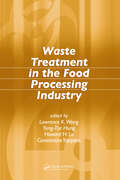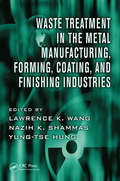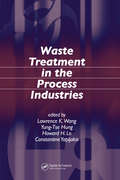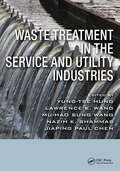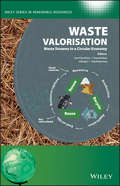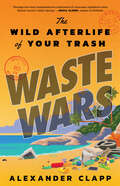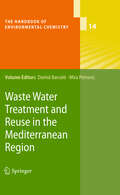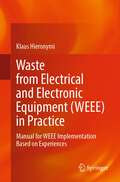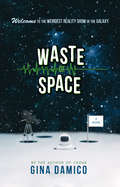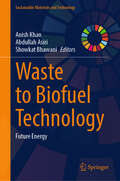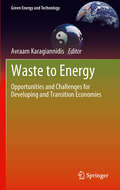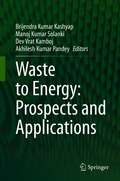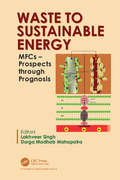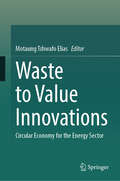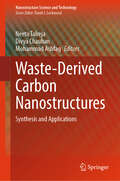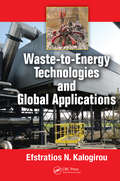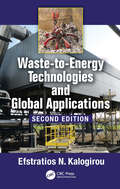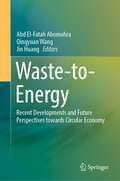- Table View
- List View
Waste Treatment in the Biotechnology, Agricultural and Food Industries: Volume 1 (Handbook of Environmental Engineering #26)
by Lawrence K. Wang Yung-Tse Hung Mu-Hao Sung WangThis book and its 2 sister books (Volumes 2 and 3) of the Handbook of Environmental Engineering (HEE) series have been designed to serve as a mini-series covering agricultural and green biotechnologies. It is expected to be of value to advanced undergraduate and graduate students, to designers of sustainable biological resources systems, and to scientists and researchers. The aim of these books is to provide information on treatment and management of agricultural, pharmaceutical and food wastes and to serve as a basis for advanced study or specialized investigation of the theory and analysis of various integrated environmental control and waste recycle systems. Volume 1 covers topics on: treatment and management of livestock wastes; waste treatment in the pharmaceutical biotechnology industry using green environmental technologies; vermicomposting process for treating agricultural and food wastes; the impacts of climate change on agricultural, food, and public utility industries; innovative PACT activated sludge, CAPTOR activated sludge, activated bio-filter, vertical loop reactor, and PHOSTRIP processes; agricultural waste treatment by water hyacinth aquaculture, wetland aquaculture, evapotranspiration, rapid rate land treatment , slow rate land treatment, and subsurface infiltration; production and applications of crude polyhydroxyalkanoate-containing bioplastic from agricultural and food-processing wastes; optimization processes of biodiesel production from pig and neem seeds blend oil using alternative catalysts from waste biomass; making castor oil a promising source for the production of flavor and fragrance through lipase mediated biotransformation; and waste treatment and minimization in baker's yeast industry.
Waste Treatment in the Biotechnology, Agricultural and Food Industries: Volume 2 (Handbook of Environmental Engineering #27)
by Lawrence K. Wang Yung-Tse Hung Mu-Hao Sung WangThis book and its sister book (Volume 1 ) of the Handbook of Environmental Engineering (HEE) series have been designed to serve as a mini-series covering waste treatment in biotechnology, agricultural and food industries . It is expected to be of value to advanced undergraduate and graduate students, to designers of sustainable biological resources systems, and to scientists and researchers. The aim of these books is to provide information on bio-environmental engineering, and to serve as a basis for advanced study or specialized investigation of the theory and analysis of various agricultural and natural resources systems. Volume 2 covers topics on: (a) application of secondary flotation-filtration and coagulant recycle for improvement of a pulp mill primary waste treatment facility; (b) management of solid and hazardous wastes; (c) microbial enzymes for wastewater treatment; (d) a multi-criteria approach to appropriate treatment technology selection for water reclamation; (e) chemicals used in agriculture: hazards and associated toxicity issues; (f) biochar for adsorptive removal of pharmaceuticals from environmental water; (g) treatment of palm oil mill effluent; (h) treatment and management of solid waste by incineration; (i) technologies for removal of volatile organic compounds (VOC) from industrial effluents and/or potable water sources; (j) treatment of healthcare waste.
Waste Treatment in the Food Processing Industry (Advances in Industrial and Hazardous Wastes Treatment)
by Lawrence K. Wang Yung-Tse Hung Howard H. LoMany standard industrial waste treatment texts sufficiently address a few major technologies for conventional in-plant environmental control strategies in the food industry. But none explore the complete range of technologies with a focus on new developments in innovative and alternative technology, design criteria, effluent standards, managerial d
Waste Treatment in the Metal Manufacturing, Forming, Coating, and Finishing Industries (Advances in Industrial and Hazardous Wastes Treatment)
by Lawrence K. Wang Yung-Tse Hung Nazih K. ShammasComprehensive in its scope and directly applicable to daily waste management problems of specific industries, Waste Treatment in the Metal Manufacturing, Forming, Coating, and Finishing Industries covers hazardous industrial waste treatment, renovation, and reuse in the metal manufacturing, forming, coating, enameling, and finishing industries. It
Waste Treatment in the Process Industries (Advances in Industrial and Hazardous Wastes Treatment)
by Lawrence K. Wang Yung-Tse Hung Howard H. Lo Constantine YapijakisIncreasing demand on industrial capacity has, as an unintended consequence, produced an accompanying increase in harmful and hazardous wastes. Derived from the second edition of the popular Handbook of Industrial and Hazardous Wastes Treatment, Waste Treatment in the Process Industries outlines the fundamentals and latest developments in waste trea
Waste Treatment in the Service and Utility Industries (Advances in Industrial and Hazardous Wastes Treatment)
by Lawrence K. Wang Yung-Tse Hung Nazih K. Shammas Jiaping Paul Chen Mu-Hao S. WangThis volume provides in-depth coverage of environmental pollution sources, waste characteristics, control technologies, management strategies, facility innovations, process alternatives, costs, case histories, effluent standards, and future trends in the process industries. It delineates methodologies, technologies, and the regional and global effects of important pollution control practices. The authors focus on new developments in innovative and alternative technologies, design criteria, effluent standards, managerial decision methodology, and regional and global environmental conservation specific to process industries.
Waste Valorisation: Waste Streams in a Circular Economy (Wiley Series in Renewable Resource)
by Christian V. StevensA guide to the wide-variety of waste valorisation techniques related to various biomass, waste materials and by products Waste Valorisation provides a comprehensive review of waste chemistry and its application to the generation of value-added products. The authors – noted experts on the topic – offer a clear understanding of waste diversity, drivers and policies governing its valorisation based on the location. The book provides information on the principles behind various valorisation schemes and offers a description of general treatment options with their evaluation guidelines in terms of cost, energy consumption and waste generation. Each of the book's chapters contain an introduction which summarises the current production and processing methods, yields, energy sources and other pertinent information for each specific type of waste. The authors focus on the most relevant novel technologies for value-added processing of waste streams or industrial by-products which can readily be integrated into current waste management systems. They also provide the pertinent technical, economic, social and environmental evaluations of bioconversions as future sustainable technologies in a biorefinery. This important book: Presents the most current technologies which integrate waste and/or by-product valorisation Includes discussions on end-product purity and life-cycle assessment challenges Explores relevant novel technologies for value-added processing of waste streams or industrial by-products which can be integrated into current waste management systems Offers a guide to waste reuse, a key sustainability goal for existing biorefineries wishing to reduce material and environmental costs Written for academic researchers and industrial scientists working in agricultural and food production, bioconversions and waste management professionals, Waste Valorisation is an authoritative guide to the chemistry and applications of waste materials and provides an overview of the most recent developments in the field.
Waste Wars: Dirty Deals, International Rivalries and the Scandalous Afterlife of Rubbish
by Alexander Clapp'A mind-altering and unforgettable read' Adam Tooze'If you wish to know how the world really works, read this book' Misha GlennyA globe-trotting investigation into the catastrophic reality of the multi-billion-dollar global garbage trade.Dumps and landfills around the world are overflowing. The millions of tonnes of garbage generated every day have given rise to waste wars, cons and cover ups across thousands of miles and multiple oceans. And few people have any idea they're happening.Roaming across five continents, Alexander Clapp delves deep inside the world of Javanese recycling gangsters, cruise ship dismantlers in the Aegean, Tanzanian plastic pickers, whistle-blowing environmentalists in the jungles of Guatemala, and a community of Ghanaian boys who burn Western cellphones and televisions for cents an hour. He reveals how most of our trash actually lives a secret second life, getting shipped, smuggled or dumped from one country onto another, with devastating consequences for the poorest nations of the world.Waste Wars is a jaw-dropping exposé of how and why, for the last forty years, our garbage has spawned a massive global black market, one that offloads our consumption footprints onto distant continents, pristine landscapes, and unsuspecting populations.
Waste Wars: Dirty Deals, International Rivalries and the Scandalous Afterlife of Rubbish
by Alexander Clapp'A mind-altering and unforgettable read' Adam Tooze'If you wish to know how the world really works, read this book' Misha GlennyA globe-trotting investigation into the catastrophic reality of the multi-billion-dollar global garbage trade.Dumps and landfills around the world are overflowing. The millions of tonnes of garbage generated every day have given rise to waste wars, cons and cover ups across thousands of miles and multiple oceans. And few people have any idea they're happening.Roaming across five continents, Alexander Clapp delves deep inside the world of Javanese recycling gangsters, cruise ship dismantlers in the Aegean, Tanzanian plastic pickers, whistle-blowing environmentalists in the jungles of Guatemala, and a community of Ghanaian boys who burn Western cellphones and televisions for cents an hour. He reveals how most of our trash actually lives a secret second life, getting shipped, smuggled or dumped from one country onto another, with devastating consequences for the poorest nations of the world.Waste Wars is a jaw-dropping exposé of how and why, for the last forty years, our garbage has spawned a massive global black market, one that offloads our consumption footprints onto distant continents, pristine landscapes, and unsuspecting populations.
Waste Wars: The Wild Afterlife of Your Trash
by Alexander ClappA globe-trotting work of relentless investigative reporting, this is the first major book to expose the catastrophic reality of the multi-billion-dollar global garbage trade. Dumps and landfills around the world are overflowing. Disputes about what to do with the millions of tons of garbage generated every day have given rise to waste wars waged almost everywhere you look. Some are border skirmishes. Others hustle trash across thousands of miles and multiple oceans. But no matter the scale, one thing is true about almost all of them: few people have any idea they're happening. Journalist Alexander Clapp spent two years roaming five continents to report deep inside the world of Javanese recycling gangsters, cruise ship dismantlers in the Aegean, Tanzanian plastic pickers, whistle-blowing environmentalists throughout the jungles of Guatemala, and a community of Ghanaian boys who burn Western cellphones and televisions for cents an hour, to tell readers what he has figured out: While some trash gets tossed onto roadsides or buried underground, much of it actually lives a secret hot potato second life, getting shipped, sold, re-sold, or smuggled from one country to another, often with devastating consequences for the poorest nations of the world. Waste Wars is a jaw-dropping exposé of how and why, for the last forty years, our garbage — the stuff we deem so worthless we think nothing of throwing it away — has spawned a massive, globe-spanning, multi-billion-dollar economy, one that offloads our consumption footprints onto distant continents, pristine landscapes, and unsuspecting populations. If the handling of our trash reveals deeper truths about our Western society, what does the globalized business of garbage say about our world today? And what does it say about us?
Waste Water Recycling and Management: 7th IconSWM ̶̶ ISWMAW 2017, Volume 3
by Sadhan Kumar GhoshThe book gathers high-quality research papers presented at the Seventh International Conference on Solid Waste Management, held at Professor Jayashankar Telangana State Agricultural University, Hyderabad on December 15–17, 2017. The Conference, IconSWM 2017, is an official side event of the high-level Intergovernmental Eighth Regional 3R Forum in Asia and the Pacific. As a pre-event of the Eighth Regional 3R Forum, it also aims to generate scientific inputs to the policy consultation of the Eighth Regional 3R Forum co-organized by the UNCRD/UNDESA, MoEFCC India, MOUD India and MOEJ, Japan. Researchers from more than 30 countries presented their work on Solid Waste Management. The book is divided into three volumes and addresses various issues related to innovation and implementation in sustainable waste management, segregation, collection, transportation of waste, treatment technologies, policy and strategies, energy recovery and resource circulation, life cycle analysis, climate change, research and business opportunities.
Waste Water Treatment and Reuse in the Mediterranean Region
by Damià Barceló Mira PetrovicWater scarcity and the need for ecological sustainability have led to the introduction of treated waste water as an additional water resource in the national water resource management plans of Mediterranean countries. Summarizing the results generated within the European Union-funded project INNOVA-MED, this volume highlights the following topics: Application of innovative technologies and practices for waste water treatment and reuse adapted to the Mediterranean regionConstraints on the application of advanced treatments and reuse of reclaimed water and sludgeProblems and requirements of sustainable water management in the Mediterranean areaThe book includes several examples of Mediterranean countries, such as Tunisia, Morocco, Egypt, Palestine and Spain, and presents their practical experiences in the application of innovative processes and practices for waste water treatment and reuse.
Waste from Electrical and Electronic Equipment (WEEE) in Practice: Manual for WEEE Implementation Based on Experiences
by Klaus HieronymiThe book is based on experiences made by the author when participating in establishing operational solutions for E-Waste legislation in many countries across the globe. Specific legislation for E-Waste, very often called “WEEE-Legislation” (Waste from Electrical and Electronic Equipment) has been a new undertaking, countries experimented with various options at the beginning, some of them were discarded, others maintained, and new options were invented. This book provides advice on the development and implementation from an operational perspective. It intends to offer to all stakeholders involved in the development and implementation of regulation for “WEEE” to benefit from the experience made in many countries across the globe. Due there is no “One Size Fits All” approach regarding various options for E-Waste legislation, the book offers insights into the various operational alternatives. The book especially outlines the operational consequences of principles that are set in the design phase of their country’s E-Waste legislation and provides advice on how to set up and manage organizations required for its successful implementation.
Waste of Space
by Gina Damico<p>Cram ten hormonal teens into a spaceship and blast off: that’s the premise for the ill-conceived reality show Waste of Space. The kids who are cast know everything about drama—and nothing about the fact that the production is fake. Hidden in a desert warehouse, their spaceship replica is equipped with state-of-the-art special effects dreamed up by the scientists partnering with the shady cable network airing the show. <p>And it’s a hit! Millions of viewers are transfixed. But then, suddenly, all communication is severed. Trapped and paranoid, the kids must figure out what to do when this reality show loses its grip on reality.
Waste of Space: A Moon Base Alpha Novel (Moon Base Alpha #3)
by Stuart GibbsA New York Times bestselling series. Tensions are running high when multi-billionaire Lars Sjoburg is poisoned and everyone is looking to Dash Gibson to solve the case in this third and final book in the New York Times bestselling Moon Base Alpha series.Moon Base Alpha was supposed to be an exciting place to live, but Dashiell Gibson didn&’t expect for it to be this exciting. He&’s already had to solve a murder and locate a missing moon base commander. Now, he just wants to have a calm, quiet thirteenth birthday. But, of course, trillionaire (and total pain) Lars Sjoburg ruins it—by being poisoned. Now there&’s another potential killer loose on Moon Base Alpha, and Dash is forced to identify the most likely suspects. Suddenly Dash finds himself with a target on his back. Whoever poisoned Lars will stop at nothing to keep his—or her—identity a secret.
Waste to Biofuel Technology: Future Energy (Sustainable Materials and Technology)
by Anish Khan Abdullah Asiri Showkat BhawaniThis book gives an overview of the latest technologies in the conversion of wastes products to biofuel or chemicals which are more eco-friendly and sustainable as compared to the ordinary petroleum derivatives. It describes a variety of technology such as combustion, gasification, paralysis, anaerobic digestion, and fermentation, which are used in the processing of solid/liquid waste produced by the different residential and industrial sectors into more economically useful by-products. The content of this book resonates with researchers, industrial practitioners, and government policymakers who are looking into developing more sustainable practices in dealing with waste products and looking into waste to energy technologies.
Waste to Energy
by Avraam KaragiannidisSolid waste management is currently a major issue worldwide with numerous areas reaching critical levels. Many developing countries and countries in transition still miss basic waste management infrastructure and awareness. It is here that many of the solid waste management problems and challenges are currently being faced. As such, waste-to-energy (WTE) consists of a proven and continuously developing spectrum and range of technologies in a number of (mostly) developed countries. However, it's integration in developing countries and systems in transition is often faced with scepticism and a complex set of barriers which are quite unique and differ greatly from those where WTE has been validated and applied over the years. Waste-to-Energy: Opportunities and Challenges for Developing and Transition Economies will address this issue both theoretically and using concrete examples, including: · contributions from numerous scholars and practitioners in the field, · useful lessons and rules of thumb, · both successful and failed cases, and · real-life examples and developments. Waste-to-Energy approaches this dynamic aspect of environmental engineering and management in a methodical and detailed manner making it an important resource for SWM planners and facility operators as well as undergraduate and post graduate students and researchers.
Waste to Energy: Prospects and Applications
by Manoj Kumar Solanki Brijendra Kumar Kashyap Dev Vrat Kamboj Akhilesh Kumar PandeyThis book addresses waste generation problems from various sectors, including industries, agriculture, and household. It focuses on how modern biotechnological approaches could help manage waste in an eco-friendly manner and generate precious bioenergy. It discusses the inadequate waste management systems damaging the environment and its adverse impacts on climate change-related problems. This book covers all the essential information regarding various types of waste and their management. It is a comprehensive compilation for understanding the efficient generation of bioenergy. It is a relevant reading material (resource) for anyone who wishes to study waste management as Chemist, Biologist, Biotechnologist, Industrialist, Ecologist, Microbiologist, Economist, and all disciplines related to the environment.
Waste to Profit: Environmental Concerns and Sustainable Development
by Anand Ramanathan Meera Sheriffa Begum K.M. Amaro Olimpio Pereira Junior Dmitrii O. Glushkov M. Angkayarkan VinayakaselviWaste to Profit: Environmental Concerns and Sustainable Development gives information about selecting the most suitable technology for waste treatment and energy recovery under different conditions. It contains techno-economic analysis, life cycle assessment, optimization of tools and technologies, including overview of various technologies involved in the treatment of wastes and factors influencing the involved processes. Finally, it explores the environmental, socioeconomic, and sustainability impact of different waste-to-energy systems. Features: Reviews energy sources and technologies from waste, their environmental interactions, and the relevant global energy policies Provides overview of waste-to-energy technologies for a sustainable future Explores physicochemical properties involved in the pertinent process and technologies Gives a multidisciplinary view about energy conversion and management, planning, controlling, and monitoring processes Discusses information in transferring the technologies' industrial level and global level to meet the requirements of different countries This book is aimed at researchers and graduate students in environmental engineering, energy engineering, waste management, waste to energy, and bioenergy.
Waste to Sustainable Energy: MFCs – Prospects through Prognosis
by Lakhveer Singh Durga Madhab MahapatraWith no emissions and water as a byproduct, the globe could imagine a sustainable and resilient human kind that obliterates any possible chances of future climate change. With increased globalization, there has been an unprecedented escalation in production processes thus generating valued products and byproducts. A significant quantum of the waste materials generated can be transformed into fuels with the help of MFCs. MFC’s utilities would bring about a paradigm shift built on the principles of sustainability, encompassing closed loop biorefinery approach. A MFC’s bio-refinery ensures complete allocation of products and byproducts in various processes yielding zero waste. Such efforts would not only help in managing waste but also contribute to generation of renewable fuel and valued products that fosters sustainable development. To cater to the needs of the present challenges in waste management, bioenergy and bio product recovery and commercial sustainability, this book on MFCs will emphasize and throw light on various mechanisms, routes and reaction engineering approaches for complete transformation of waste to wealth.
Waste to Value Innovations: Circular Economy for the Energy Sector
by Motaung Tshwafo EliasThis book highlights a need to engage research and innovation for energy production from waste given the challenges of insufficient electricity in most developing countries. It also highlights current policies and regulations to fast-track development of new technologies for renewable energy in developing countries. The chapters are tailored to support academics, industries and investors with competent approaches for starting groundbreaking projects. Investors will find the book relevant as it gives bearing of the new waste streams and forecast in Africa and the world. The knowledge in it gives channels to the world competent practical solutions in renewable energy. All the gaps related to waste and energy are well identified in South Africa and other selected counties.
Waste-Derived Carbon Nanostructures: Synthesis and Applications (Nanostructure Science and Technology)
by Neetu Talreja Divya Chauhan Mohammad AshfaqThis contributed volume focuses on the development of waste-derived carbon nanostructures (WD-CNs) from various waste materials, such as municipal garbage, plastics, industrial waste, and agricultural residues, highlighting their potential for recycling in a circular economy. It explores synthetic processes that convert waste into valuable carbon nanomaterials, reducing the need for cleansing and lowering the carbon footprint compared to traditional methods. The book also examines the functionalization of WD-CNs for diverse applications in energy, environment, and biology, promoting sustainable innovation and commercialization of green technologies. It is a useful tool for researchers, graduate students and professionals working in the fields of materials science, nanotechnology, environmental science, and chemical engineering.
Waste-to-Energy Technologies and Global Applications
by Efstratios N. KalogirouThrough Waste-to-Energy (WtE) technology, plants use waste as a renewable fuel to co-produce electricity, heating, and cooling for urban utilization. This professional book presents the latest developments in WtE technologies and their global applications. The first part of the book covers thermal treatment technologies, including combustion, novel gasification, plasma gasification, and pyrolysis. It then examines 35 real-world WtE case studies from around the world, analyzing technical information behind planning, execution, goals, and national strategies. Results through the years show the benefits of the technology through the life cycle of the products. The book also examines financial and environmental aspects.
Waste-to-Energy Technologies and Global Applications
by Efstratios N. KalogirouThrough waste-to-energy (WtE) technology, relevant WtE plants use waste as a renewable fuel to co-produce electricity, heating, and cooling for urban utilization. Updated to reflect the latest developments in this field, the second edition of Waste-to-Energy Technologies and Global Applications also adds three new chapters covering waste to hydrogen, carbon capture and storage/utilization, and additional discussion on new WtE plants in Dubai and the Middle East. Covers thermal treatment technologies including combustion, novel gasification, plasma gasification, and pyrolysis Examines dozens of real-world WtE case studies from around the world, analyzing technical information behind planning, execution, goals, and national strategies Explains financial and environmental aspects Features new content on waste to hydrogen, carbon capture and storage/utilization, and new WtE plants in Dubai and the Middle East This book is aimed at professionals in environmental, chemical, energy, and related fields of engineering. It will also be of interest to policy-making governmental authorities, construction companies, and financial institutions.
Waste-to-Energy: Recent Developments and Future Perspectives towards Circular Economy
by Jin Huang Abd El-Fatah Abomohra Qingyuan WangThis book addresses the needs of students, researchers, as well as engineers and other professionals or readers interested in recent advances of biofuel and efficient waste management. In the context of energy consumption, over 85% of the total consumed energy comes from non-renewable fossil resources. Developing new renewable energy resources, especially biofuel production from wastes, has received increasing attention. The book is organized into three sections, namely Section I: Conventional waste management; Section II: From waste to green energy; and Section III: Case studies and future perspectives. Each section presents topic-specific chapters, which contain comprehensive and advanced knowledge of the subjects. Overall, the book covers the recent advances, breakthroughs, challenges, and future perspectives of waste-to-energy approach using different kinds of wastes as a feedstock for alternative biofuels and other integrated approaches such as wastewater treatment, plastic degradation, and CO2 sequestration in a cost-effective and eco-friendly way. In addition, different routes of waste recycling for enhanced biofuel production and case studies are presented with environmental and economic analysis. The presented case studies and future perspectives under Section III complement the chapters as they are authored by experts from bioenergy businesses who actually encounter real-world problems.


